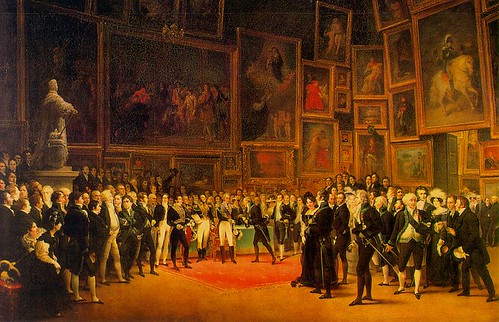Francois Joseph Heim (French, 1787-1865) Charles X Distributing Awards to Artists Exhibiting at the Salon of 1824 at the Louvre (1827) MuseÌe du Louvre, Paris
In his book, The Judgment of Paris, Ross King compares Salon attendance to today’s most visited museum exhibitions:
[The Salon was] one of the greatest spectacles in Europe, it was an even more popular attraction, in terms of the crowds it drew, than public executions. Opening to the public in the first week of May and running for some six weeks, it featured thousands of works of art specially—and sometimes controversially—chosen by a Selection Committee. Admission on most afternoons was only a franc, which placed it within easy reach of virtually every Parisian, considering the wage of the lowest-paid workers, such as milliners and washerwomen, averaged three to four francs a day. Those unwilling or unable to pay could visit on Sundays, when admission was free and the Palais des Chaps-Élysées thronged with as many as 50,000 visitors—five times the number that had gathered in 1857 to watch the blade of guillotine descend on the neck of a priest names Verger who had murdered the Archbishop of Paris. In some years, as Many as a million people visited the Salon during its six-week run, meaning crowds averaged more than 23,000 people a day*
*To put these figures into context, the most well-attended art exhibition in the year 2003 was Leonardo da Vinci: Master Draftsman, at the Metropolitan Museum of Art in New York. Over the course of a nine-week run, the show drew and average of 6,863 visitors each day, with an overall total of 401,004. El Greco, likewise at the Metropolitan Museum of Art, averaged 6,807 per day during its three-month run in 2003-4, ultimately attracting 574,381 visitors. The top-ranked schibition of 2002, Van Gogh and Gaugin, at the Van Gogh Museum in Amsterdam, drew 6,719 perday for four months, with a final attendance of 739,117.
(Ross King. The Judgment of Paris. New York: Walker and Company, 2006. p. 17)
Comparing the Paris Salon to modern-day museum exhibitions is probably unfair. In the nineteenth century–before the advent of photography, radio, and movie theaters–painting was truly the most public art form. A more appropriate comparison would mostly likely be comparing Salon attendance to movie ticket sales. (How about comparing Ernest Meissonier’s painting Friedeland, the painting sold for the highest price in the nineteenth century and a Salon blockbuster, with Batman Begins?)

Ernest Meissonier (French, 1815-1891) 1807, Friedland (c. 1861-1875), Metropolitan Museum of Art, New York
If that is true, it would also be appropriate to consider the Paris Salons as some of the most culturally significant and telling events of the nineteenth century. Recently, while undertaking a research question, I was surprised to learn that there is little published about the Salon as an intitution previous to or after the Salon de Refusées in 1863.
